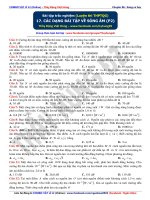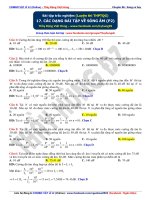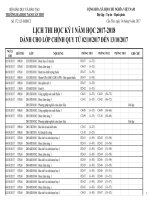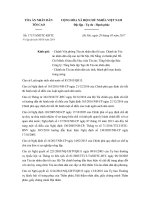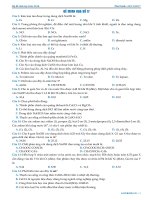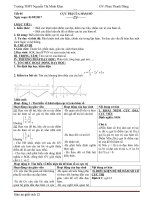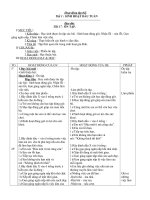Cs224W 2018 17
Bạn đang xem bản rút gọn của tài liệu. Xem và tải ngay bản đầy đủ của tài liệu tại đây (7.45 MB, 10 trang )
Empirical Study and Experiments on Information
Virality Using Twitter Higgs Dataset
Zilong Wang
(zilong @stanford.edu)
Zhiging Zhang (zhiging
@ stanford.edu)
I.
INTRODUCTION
II.
A.
Since the beginning of this century, the number of users consuming social medias has grown
exponentially. According to Global Digital Report
2018, the number of social media users worldwide
is 3.196 billion, representing more
than 75%
of
the 4.021 billion internet users worldwide in 2018
[1]. Accompanying such tremendous growth is the
gradual shift of social activities, marketing, advertising, and news consumption from offline to on-
line as social networks provide the perfect medium
of people, connected by similar backgrounds or
interests, for information to spread.
The
intrinsic
structure of social networks also influences the
way information propagates. For example, news
could spread differently on Facebook, where social connections are undirected, versus on Twitter,
where connections are directed. The rise of social
networks has made it easier to access information,
but also brought along issues like fake news that
sway public opinions much faster than traditional
news media. To prevent fake news from virally
spreading, we will first need to understand how
news spreads across social network.
Our
a
proposed
scientific
rumor
project
[2]
aims
spreads
to
exam
across
how
network. In this proposal, we summarize and
critique three relevant papers on Twitter network
analysis and Information Cascade. Our project
will leverage and extend what is discussed
in these papers to examine how information
cascades spread across the network, identify
communities and hub nodes, and explore the roles
of social network, local community structure, and
information cascade structure in viral outbreak..
LITERATURE
REVIEW
Social networks that matter: Twitter under the
microscope
Social networks on Twitter are often constructed
from a list of declared followers and followees (i.e.
people followed by a user) for analysis. In contrary
with this popular practice, Huberman, Romero, and
Wu investigate the underlying social networks constructed by the pattern of interactions that people
have with their actual friends or acquaintances in
this paper. Huberman et al. define a users friend
as another user whom the user has directed at
least two posts to (i.e. two @ interactions in posts
or comments) and discover that on average, 90
percent of a users friends reciprocate attentions
by being friends of the user as well. However,
Twitter users have a very small number of friends
compared to that of their followers and followees,
implying a sparse network of actual friends underlying a dense network of followers/followees.
They also show that this social attention is the key
factor driving Twitter usage - the number of total
posts saturates at less than 1000 as the number of
followers increase while the number of total posts
is positively correlated with the number of friends
until it reaches a maximum point of 3201.
Huberman et al. provides some interesting insights on the effect of actual friend network underlying the follower-followee network on Twitter
usage. We are planning on applying this hidden
network analysis to our data set to see how friend
network could contribute to the spread of news on
Twitter. However, this paper solely emphasizes the
social aspect of Twitter network and lacks analysis of Twitter usage as a source of information.
In reality, Twitter is used by many people as a
news source just as much as a social network.
There could exist users who have little interaction
with friends yet still very active by proactively
following public figures and sharing their posts and
comments. We are interested in identifying these
information hubs (public figures/accounts) and the
follower communities around them to study how
in order to account for unexpected fast increase of
active users in the beginning and rapid decrease
after the announcement.
This article uses several brilliant modeling
techniques to provide insights into spatio and
mostly temporal patterns of the Higgs particle
communities.
are many more aspects to be integrated in this
network analysis that could potentially yield
better understanding of the spread dynamics. First
of all, the paper largely ignores the community
structural topology and bases the analytical model
on the assumption that local correlation plays
a small part in spreading information across
network. In reality, twitter networks tend to have
many different subgraph structures. Some Twitter
accounts tend to serve as a information hub node,
connecting and broadcasting to a large number
of nodes, while many other nodes tend to serve
as information consumption nodes and rarely get
retweeted. Secondly, while the paper provides a
insightful view into how the news was spread in
terms of number of tweets and active users, it
would also be interesting to learn the topological
pattern of the spread dynamics over time. Does
the information tends to spread within tightly-
information
Moreover,
flows
the
into,
across,
definition
of
and
out of these
friend
used
in
Huberman et al. appears to be another weakness.
This paper defines friend as anyone who a user
has directed a post to at least twice, which is too
broad a definition in the context of real Twitter
interactions. Any user could easily direct a post to
a public figure (lets say New York Times) multiple
times without being friends of each other. In our
project, wed like to strengthen the definition of
friend by requiring reciprocate following and
explore how friend networks influence the spread
of information across communities.
B. The Anatomy of a Scientific Rumor
This article is the original publication on Nature
that analyzes how the news of the discovery of a
Higgs boson-like particle at CERN spreaded on
Twitter and studies the spatial-temporal patterns
of the information spreading across the network at
local and global scale. The dataset and graphs of
our proposal are also originally collected for this
paper. The paper first provides Macroscopic and
Microscopic plots of number of tweets in terms
of inter-tweet time and inter-tweet space during
different phases of the announcement. It unveils
the bursty nature of user activities and refers to
studies suggesting that spreading dynamics over
complex network is influenced more by decisionbased queuing processes and less sensitive to the
overall network topology. The paper then further
inspects the information spreading by modeling the
dynamics of user activation first without user deactivation, then with deactivation. The author uses
the assumption that neighborhood level correlation
contribute little to the spread dynamics and uses a
scale-free degree distribution to estimate if a nonactive user is connected to active user. A largescale data simulation is performed to validate this
analytical model and a decaying activation rate is
introduced for decreasing user interest over time
announcement,
however
we
believe
that
there
related social communities faster, or does it reach
broader audience first, then slowly saturate within
the communities? Are there information hubs,
or Centers of stars nodes and do they play an
important role in spreading information across the
network? We believe answering these questions
with more diverse network analysis techniques
can help us better understand the spread dynamics
in this twitter network.
C. The Structural Virality of Online Diffusion
To quantitatively understand how viral product
or information diffuses, Goel et al. proposes a
new measure of structural virality that interpolates between information that diffuses through
one single large broadcasting and information that
spreads through generations of relatively smallsized adaptations. By applying the concept of
structural virality to the propagation of a variety of
Twitter datasets, Goel et al. discovered that online
popularity growth is made possible by a diverse
combination of broadcasting and viral spreading,
but often times driven by the largest broadcast,
which keeps the structural virality low.
We find the study of The Structural Virality
of Online Diffusion a very interesting article. It
provides many fundamental methodologies on
how to model and study online diffusion, such as
using structural diversity and structural virality as
a continuous measurement of a diffusion tree. We
would definitely try out structural virality analysis
for our data as well, but we would love to take it
further and compute a weighted structural virality
index value by incorporating the retweet,reply and
mention graphs together and assigning different
weights to each edge according to corresponding
feature set.
Ill.
A.
Problem
METHODS
Statement
The spreading dynamics of the discovery of
Higgs particle through Twitter is a complex process. Does it follow a broadcast-type model, in
which a popular node broadcasts to a large number
of followers? Or does it more resemble a multilayered viral spreading model, where the news
travels through many Twitter friend circles to reach
a large audience? In particular, how should we
model and study the spread of information through
large network systematically?
In this project, we want to answer the above
questions by studying the Higgs information cascade diffusion trees in the context of the underlying
twitter social network. Our initial empirical analysis will incorporate a wide range of features, such
as the size, the root node degree, the average depth
and the structural virality of the diffusion trees, and
then closely examine how these features contribute
to the overall size and structure of the information
cascade. A microscopic examination of a few example cascades are visualized and analyzed using
plotting tools. With the insight from our data
analysis,
we
will further model
how
community
structures influence the spread of information by
labeling communities with Louvain algorithm. In
our final experiment, we will augment the initial
Retweet graph with additional weight and edges
from all of the findings above, and perform cascade
prediction on the new graph. The goal is that given
a diffusion
tree
at certain
time,
our
model
will
be able to predict whether the diffusion tree will
keep the viral spreading pattern or not, given the
features generated from the current tree.
The project contains the following components:
B.
Dataset
In this project, we took advantage of the Higgs
Dataset
[2]
that
is readily
available
on
SNAP. This dataset was originally collected via
the Twitter API by Domenico et al. before, during
and after the announcement of the discovery of
a Higgs boson-like particle at CERN between
Ist and 7th July 2012. User activities that
helped spreading this scientific rumor including
retweeting,
mentioning,
and
replying,
were
reported. From this data, four directional graphs
of twitter activities and one directional graph of
social relationships were extracted.
C. Network Properties
The social network is a directed graph that reflects follower/followee relationships between active Twitter users who reacted to the discovery of
Higgs particle. It is composed of 456626 nodes
and 14855842 edges, with an average clustering
coefficient of 0.1887.
The retweet network is a directed and weighted
graph that represents retweet actions between
users. It contains 256491 nodes and 328132 edges
with an average clustering coefficient of 0.0156.
Like retweet, the reply network is another directed and weighted that reflects reply actions
between users. There are 38918 nodes and 32523
edges in this network. Its average clustering coefficient is 0.0058.
Lastly, the mention network is a directed
and weighted graph that represents the mention
interactions between users. There exists 116408
nodes and 150818 edges in this network. Its
average clustering coefficient is 0.0825.
D.
Community Detection
As mentioned in the problem statement above,
in order to understand how social communities
play their roles in the spreading of information, we
would like to first explore the kind of communities
that exist in the twitter social network. Due to
the nature of social relationships, we expect that
community structures exist intrinsically in the social network. For this classic community detection
problem, we adopted the Louvain algorithm as it
provides a fast means to detect communities in
a large network. Louvain algorithm is a greedy
optimization method that aims to optimize the
modularity of a partition of the network.
The modularity of a partition is defined as:
1
2M
Q
kik;
[ay — SH]
Ô(Œ¡, €;)
(1)
where A;,; represents the weight of the edge between i and j, k; = 3°; A;,j; represents the sum of
the weights of the edges attached to vertex 2, c; is
the community
to which
and
Aj; [5].
6 function 6(u,v) is 1 if
2M
=
Ad
vertex 2 is assigned, the
=
v and 0 otherwise
As described in Blondel et al., each pass of the
Louvain algorithm contains two phases:
1) Phase 1
e Start with each node in its own community.
e For each node i, loop through all its neighbors
j and evaluate the gain in modularity by
removing i from its current community and
placing it in js community. Node i is then
placed in the community that maximizes gain
in modularity.
¢ If no positive gain is possible, 1 remains in
the original community.
e Repeat the above process for each node until
no further improvement is possible.
2) Phase 2
e Contract the original graph G to a new graph
H by making each community found in Phase
1 and node. The weights of edges between
two nodes in H is equivalent to the sum of the
weight of edges between the corresponding
two communities in G. The sum of weights of
edges within a community in G is converted
to a self-edge of the same weight in H.
Repeat Phase 1 and 2 until no improvement in
modularity is possible, which means optimization
is reached.
For this project,
instead of implementing
the
Louvain algorithm from scratch, we had used the
community detection
achieve this goal.
module
for NetworkX
to
E. Diffusion Tree
In this project, diffusion tree is used to model
the cascade of information through twitter. We first
generated a list of diffusion trees using the twitter
Higgs time-activity data. Each row in the dataset
represents a diffusion event (edge)
the from” (source node) and ”to”
and contains
(target node)
user IDs, the interaction type (retweet, mention,
or reply), and the timestamp. If the source node
of any event has never been referenced in any
previous diffusion event, we then define it as a
”seed node”, which serves as the root node of a
new diffusion tree. We also made the assumption
that the diffusion tree that a node belongs to does
not change
once
it is first set, though
it can be
the target of diffusion events from other diffusion
trees. By iterating through the Higgs time-activity
data, diffusion trees are generated and grown in a
temporal order. By the end of this processing, four
sets of diffusion trees are generated for retweet,
mention, reply, and all activities. Note that diffusion trees with less than 2 nodes are filtered out to
reduce noise.
F. Structural Virality
There exists various ways to define the virality
of a graph. For this project, we adopted the defi-
nition of structural virality v(T’), discussed in the
Goel et al. paper, as the average shortest distance
between all pairs of nodes in a diffusion tree T:
0)
T)
=
n(n
1
——_
n
n
1) dd thy`
(2)
where dij denotes the length of the shortest path
between nodes 2 and 7. This definition also known
as Wiener index and provides a continuous measure of structural virality. The higher the value of
0(7) is, the farther apart the adopters are from
each other in the cascade, thus suggesting an viral
diffusion event deep into many layers of nodes. On
the other hand, a lower value of ø(7) generally
Algorithm
1 (Computing
v(T))
Require: T is a tree rooted at node r
function
SUBTREE-MOMENTS(T, r)
if T.size() =1
3:
size
4:
5:
6:
7:
8:
then
Proportion of the communities with a given size (log)
1:
2:
Size Distribution of Social Communities
> The base case
— 1
sum-sizes <— 1
sum-sizes-sqr <— 1
else
> Recurse over the children of the root r
for c € r.children() do
size., sum-sizes,, Sum-sizes-sqr,
<— SUBTREE-MOMENTS(T, c)
size — 0
sum-sizes <— 0
sum-sizes-sqr <— 0
9:
10:
11:
12:
for c € r.children()
13:
14:
do
10-1
4
10-2
4
T
101
size <— size +size.
sum-sizes < sum-sizes +sum-sizes,
15:
sum-sizes-sqr <—
16:
17:
18:
sum-sizes-sqr <—
19:
return
20:
Hig. 2.
+ sum-sizes-sqr,
size, sum-sizes,
sum-sizes-sqr
dist... <—
r)
[2-size/(size — 1)]x
[sum-sizes/size — sum-sizes-sqr /size”]
return dist...
23:
Fig. 1.
0.
algorithm for calculating v(T’) proposed
by Goel et al is represented by Fig. 1. In
our project, we took advantage of an API for
calculating average length of shortest path of a
graph conveniently provided by NetworkX.
G.
In this section, we further explored the idea of
predicting if a certain diffusion tree will go viral
given its current characteristics. We generated 2
of features,
one
derived
from
the
diffusion
tree and its corresponding social graph, another
from the community detection results. The aim is
to compare whether adding additional feature sets
based on community labels can further improve
our models prediction accuracy, thus arguing how
important local communities play an role in the
diffusing process.
To
generate
the
Once we generated the necessary data feature
sets and corresponding labels, we randomly split
the data into 90% for training and for 10% testing,
and then we feed the data into a Random Forest
classifier with 100 trees to train our model.
1) Feature Set
The first 5 columns of
community
labels
(Table
feature set without
II)
and
of
with
community labels (Table III) can be viewed below.
Outbreak Detection
sets
detected from Social
a label of 1. Otherwise, the tree is given a label of
Algorithm for computing v(T) by Goel et al.
suggests a less viral event, thus more resembles a
noisy broadcast model.
The
Size distribution for communities
stamp (1341403280) which occurred shortly after
the main news broke out on Twitter and take a
snapshot of all the diffusion trees at this point of
time. We then compare each diffusion tree with its
final form at the end of the data collection. If the
diffusion tree has doubled its size in the given time
window, we will consider it to be viral and give it
sum-sizes-sqr
SUBTREE-MoMENTs(T,
22:
T
10°
+ size
function AVERAGE-DISTANCE(T, r)
21:
T
104
network
sum-sizes-sqr + size”
size, sum-sizes,
T
103
Social community size (log)
sum-sizes-sqr
size <— size+1
sum-sizes <— sum-sizes
T
102
labels,
we
selected
a
time
a) ID
ID of the Diffusion Tree. Each diffusion tree
will have a unique id. The tree id is only for
identification purpose and it is not part of the
feature set.
b) Root Deg
The degree of the root node of a diffusion tree.
A high root node degree in diffusion tree usually
indicates a broadcast diffusion model.
c) Root Deg Social G
The degree of diffusion tree’s root node in the
original social graph.
Degree Distribution of In, Out, and Total degree for Retweet network
10°
101
102
Node Degree (log)
—
In Degree
—
—
Out Degree
Total Degree
103
Degree Distribution of In, Out, and Total degree for Mention network
10°
Proportion of Nodes with a Given Degree (log)
Proportion of Nodes with a Given Degree (log)
10°
10%
10°
Degree Distribution of In, Out, and Total degree for Reply network
10°
—— In Degree
10°
101
Fig. 3.
102
Node Degree (log)
Out Degree
Total Degree
10°
The total number of nodes in the diffusion tree.
f) Edge Cnt
The total number of edges in the diffusion tree.
g) Root Community Size
The size of the community that the root node
belongs to.
h) Largest Community Density
Representation of the density of the largest
community within the current diffusion tree. This
feature measures if the diffusion tree is currently
dominated by a certain community or evenly
spread through several different groups. The value
of the largest community density is calculated by:
where C; represents
appearance of a single
C?
Ni
(3)
the largest count of
community within the
diffusion tree, and N; is the total number of nodes
of the community.
Out Degree
Total Degree
103
104
101
102
——
In Degree
——
—
Out Degree
Total Degree
103
104
Node Degree (log)
Degree distributions for Retweet, Mention, Reply, and Social networks
Cnt
Xj
In Degree
——
—
Degree Distribution of In, Out, and Total degree for Social network
103
d) Structural Virality
The structural virality value of the diffusion tree
e) Node
102
Node Degree (log)
Proportion of Nodes with a Given Degree (log)
Proportion of Nodes with a Given Degree (log)
—
—
101
——
IV.
RESULTS AND DISCUSSIONS
A. Summary Degree Distribution
Our first step is to generate the degree distribution of the four networks to get an idea of what we
can expect from the data and how the networks are
distributed. As shown by the graphs above, the in,
out, and total node degree distributions for social,
retweet, reply, and mention networks all follow a
similar power-law distribution, which is expected
in real-world networks.
The social network has
node
degrees,
which
makes
some
sense
of the
largest
intuitively
as
the degree for each node in the retweet, reply
and mention graph cannot exceed that of the
social graph. Among the three twitter interactions
graphs, retweet and mention graphs have the
larger distribution of nodes with high degree,
whereas the reply graph hosts more nodes with
small degree.
B. Community Size Distribution
Since
the
Louvain
community
detection
algorithm assumes undirected graph, we had
to convert
these
twitter interaction
graphs
is 2075,
the
mode
and
median
community
size
are both 2 - there are 137 communities with a
size of 2 and large communities are very few.
Diffusion Tree Size v.s. Average Tree Depth
104 +4
Average Tree Depth For a Tree of Size x
to undirected before performing
community
detection. 220 communities were successfully
identified from the twitter social network. Fig.
2 represents the distribution of communities
detected by the Louvain algorithm. Of these 220
communities, the largest community contains
125344 nodes, whereas the smallest community
contains only 2 nodes. The mean community size
103 4
102
4
10!
4
——
Retweet
—
—
Mention
Reply
——
All Activities
T
101
T
102
T
103
T
104
Size of The Diffusion Tree
C. Traits of the Diffusion Trees
Our next step is to generate the list of diffusion
trees for each graph, and then plot the fundamental
traits such as degree distribution, average depth
and cascade size for each graph. Fig. 4 shows two
example diffusion trees (19271 and 928) from the
all activity network.
Fig. 6.
CCDF
All Activities
1)
Cascade Size
The loglog plot of Fig. 5 gives us an overview
of the sizes of cascade trees for each graph. The
All Activity and Retweet networks have the largest
cascade
Tree
set
19271
and 928 constructed from total activity data
CCDF of Cascade Size for Retweet, Mention, Reply, and All Activities
10
——
Retweet
—
——
Reply
All Activities
CCDF Percentage %
—
10!
4
10°
4
r
101
7
102
7
103
Mention
7
104
Cascade Size
Fig. 5.
CCDF
All Activities
in terms
of size, where
as Mention
and
Reply networks have relatively small cascades.
This makes sense intuitively as retweeting can
be regarded as the strongest among the three in
terms of reaching out to a broad audience, as it
is the main catalyst of information cascade. It is
not surprising that the All Activity curve closely
resembles the Retweet curve.
&
Fig. 4.
of cascade size for Retweet, Mention, Reply, and
of cascade size for Retweet, Mention, Reply, and
2) Average Depth
Figure 6 shows high correlation between the
average depth of diffusion trees and the size of
the diffusion trees for all four networks. This
tells us that larger diffusion tree often means
information diffuses to deeper layers, possibly
inferring that as the information cascade grows
bigger, it demonstrates more characteristics of
viral diffusion than a broadcast. Otherwise, the
average depth will be flatter, indicating that the
diffusion tree size is more correlated to the degree
of celebrity nodes.
3) Root Node Degree
There are studies that focused on utilizing features of the root node as key indicator, and the
conclusion is that celebrity nodes with a higher
degree reaches larger audience and thus spreads
further. Users with large follower counts on Twitter
Diffusion Tree Size v.s. Root Degree for Retweet
10000
Diffusion Tree Size v.s. Root Degree for Mention
Root Degree
6000
+
Root Degree
8000
4000
2000
0
25
2000
4000
6000
8000
Size of The Diffusion Tree
10000
10
Diffusion Tree Size v.s. Root Degree for Reply
15
20
Size of The Diffusion Tree
25
30
Diffusion Tree Size v.s. Root Degree for All Activities
4000
20
Root Degree
Root Degree
3000
2000
1000
0
Size of The Diffusion Tree
Fig. 7.
tie te
0
2000
*
4000
6000
8000
Size of The Diffusion Tree
*
10000
Cascade size v.s. Total root degree in Retweet, Mention, Reply, and All Activities
generated the largest retweet cascades.[6] By plotting the relationship between tree size and the root
node degree (Fig. 7), we hope that it can confirm
our hypothesis from 2) above that the spread of
the Higgs particle news resembles more of a viral
diffusion.
After examining the plots above, we have drawn
some interesting insights:
e The cascading dynamics is a mix of viral
diffusion and broadcast diffusion. While all
four graphs exhibit similar trends, the All
Activity plot appears to support the mixed
cascading dynamics most significantly. In the
All Activity plot, we see a clear separation
of two types of trees - those with high root
degree but relatively low cascade size compared to the best fitting line, indicating a
broadcast diffusion, and those with low root
degree but high cascade size, a classic viral
diffusion. Compared to the All Activity plot,
the Retweet plot is also showing a mixture
of the two dynamics, but less significantly.
There is no cascade that grows virally to over
10000 nodes by retweet only, as we do see
in all activities. Mention and Reply plots are
relatively sparse, which is expected as they
have fewer data points, but they do show a
mixture of both as well.
e By plotting the linear regression of of
each graphs data, we see a general upward
correlation between the root node degree and
cascade size. This observation lies with the
previous finding that the spreading dynamics
for Higgs news is a mixture of broadcast and
viral diffusion events.
D. Structural Virality
In Fig. 8, we plotted the complementary cumulative distribution function of structural virality
for each graph. This graph reinforces our previous
finding that structural virality varies from about
1 to 5, indicating that the diffusion trees are a
mix of short/wide broadcast trees as well some
as deep/spread-out word-of-mouth trees. We also
have the similar observation
as in study
[5], that
there is no bi-modal distribution structure for structural virality. This indicates that there is no tipping
point for diffusion, compared to some of the classic
theories. Another interesting observation here is
CCDF of Structural Viralty for Retweet, Mention, Reply, and All Activities
10
—
Retweet
—
Mention
——
Correlation Between
Reply:
0.8 3
CCDF Percentage %
—— All Activities
101
0.6 +
0.45
0.2 3
10°
0
1
Cascade Structural Viralty
that Twitter mention is slightly more viral than
retweet, which could suggest that the inner social
network and close communities play a crucial role
in information cascading.
Figure 9 illustrates the correlation coefficient
between structural virality and the size of cascade.
As we can see, all four graphs show a positive
correlation between size and virality, indicating
that the major driving force behind cascade
growth is likely word-of-mouth diffusion. Among
the four graphs, Reply graph has the highest
correlation coefficient, closely followed by the
Mention graph. All activities and Retweet graph
shared the same low correlation, indicating that
high cascade size does not necessarily infer
high structural virality, and the total activity is
dominated by retweet.
Outbreak Prediction
Table I represents the results of the prediction
while Table II and III show the values of the
T
0.0
5
Fig. 8. CCDF of Structural Virality for Retweet, Mention, Reply,
and All Activities
E.
Structural Viralty and Cascade Size
Fig. 9.
V.
LIMITATION
likely because
of the lack of sufficient data and effective features
for training. A slight improvement in accuracy is
obtained by adding the community features into
the training set, however it is too small to have any
statistical significance. This result corresponds to
our previous observation that most viral diffusion
events are dominated by broadcasting model rather
AND
FUTURE
WORK
a)
First limitation we run into is that the majority
of the diffusion trees only end up having 1 or
2 edges. Therefore, the majority of the diffusion
trees will be classified as *non-viral”, resulting a
high bias in our classification model. To combat
this problem, we experimented with the idea of
number
models,
T
All Activities
1) Limitation
f scores
in both
Reply
than from one local community to another local
community.
From this experiment, we can conclude that
viral spreading from one local community to
another local community does not contribute
much to increasing the chance that a diffusion
event to become even more viral, although it
does happen infrequently. Therefore, including
the community detection derived features does
not significantly improve our prediction accuracy.
a minimal
are low
T
Mention
Correlation between Structural Virality and Cascade Size
feature set. As seen from Table I, we do not have
a highly accurate classifier to detect outbreak. the
T
Retweet
tree
size
threshold,
which
filters
out
diffusion trees that contain fewer than a certain
of
nodes
(5)
in
our
case.
While
this
approach is effective in reducing noise in the
data, it greatly reduced our sample size from 40k
5k, leaving us susceptible to high variance and
over-fitting. We used Random Forest algorithm
with 100 500 trees to compensate for this problem,
but the improvement is not significant.
TABLE
PREDICTION
Feature Set
Without Community
With Community
Accuracy
SET EXAMPLE
SET EXAMPLE
WITH
b)
Another limitation in our prediction machine
learning algorithm is choosing the specific time
stamp for the ’snapshot” and then defining the
threshold for virality. Choosing a time stamp too
early would mean most of the diffusion trees still
have only 2 to 3 nodes and as a result, most
of them will double its size by the end of the
data collection period. In this scenario, we will
need a high threshold for virality. For example,
only diffusion trees that quadruple its size in the
end
can be labeled
as viral.
On
and it is indeed
very difficult to have
a
generic and accurate model to predict whether an
event will go viral.
c)
COMMUNITY
FEATURES
III
COMMUNITY
FEATURES
requires deep domain expertise in the field, and
it is prone to humane subjectivity. Even though
we tried our best to select features we think are
essential
in
outbreak
detection,
it
is
far
from
perfect and can be improved with further study of
the subject.
APPENDIX
Github Repo: 1993/cs224wproject
the other hand,
choosing a time stamp too late would mean that
most of the diffusion trees have already passed the
viral spreading period, thus they are unlikely to
continue doubling the tree size. In this scenario,
a smaller virality threshold is required to reduce
bias in the model. We have performed dozens
of experiments with different combinations of
threshold, and we are unable to consistently
perform over an accuracy of 0.75. This result
implies that outbreak is a complex and random
process,
Weighted Avg fl-score
0.61
0.65
II
WITHOUT
TABLE
FEATURE
FOR TEST DATA
0.6218487394957983
0.6659663865546218
TABLE
FEATURE
I
ACCURACY
We also have a limited feature set. The intention
here is that by explicitly selecting features, we
can mitigate some of the impact of small data
problem. However, effective feature selection
REFERENCES
[1]
[2]
/>M. De Domenico, A. Lima, P. Mougel and M. Musolesi.
The Anatomy of a Scientific Rumor. (Nature Open Access)
Scientific Reports
[3]
B.A.
Huberman,
3, 2980
D.M.
(2013).
Romero,
F. Wu.
Social networks
matter: Twitter under the microscope.
2009.
[4]
Goel,
[5]
Blondel, Vincent
The
S., Anderson,
Structural
Science,
[6]
62,
A., Hofman,
Virality
of Online
First Monday,
J.M.,
Watts,
that
14(1),
D.J.
(2016).
Lambiotte,
Renaud
Diffusion.
Management
180-196.
Guillaume,
Jean-Loup
Lefebvre, Etienne. (2008). Fast Unfolding of Communities in
Large Networks. Journal of Statistical Mechanics Theory and
Experiment. 2008.
Bakshy
E,
Hofman
JM,
Mason
WA,
Watts
DJ
(2011)
Ev-
eryones an influencer: Quantifying influence on twitter. Proc.
Fourth ACM Internat. Conf. Web Search and Data Mining
(Association for Computing Machinery, New York), 6574.

